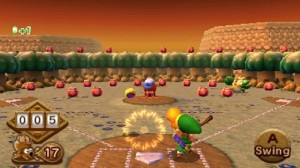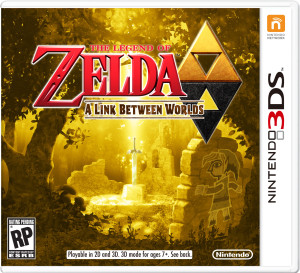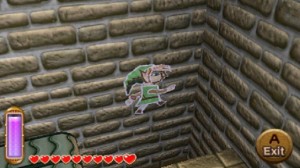Developed by Nintendo and Monolith Soft, The Legend of Zelda: A Link Between Worlds is the first original Zelda game to be released for the Nintendo 3DS. A Link Between Worlds is the spiritual successor to one of gaming’s greatest titles, The Legend of Zelda: A Link to the Past, and it is obvious that this classic served as an inspiration to the development team. What may not be so obvious is if A Link Between Worlds manages to live up to the lofty expectations that come with the territory of being the sequel to a classic game.
Set six generations after the events of A Link to the Past, A Link Between Worlds‘s kicks off with the mysterious villain, Yuga, imprisoning Hyrule’s Seven Sages in paintings one-by-one. Princess Zelda gives Link the quest to stop Yuga, which eventually leads to Link obtaining the Master Sword. Link arrives back at Hyrule Castle just in time to see Yuga imprison Zelda in a painting and slip through a crack in Zelda’s study that leads to Lorule, a darker version of Hyrule. By the time Link finds him, Yuga has revived Ganon and fused with him to take control of the Triforce of Power. Lorule’s Princess Hilda traps Yuga-Ganon and informs Link that the Seven Sages are spread out across the world of Lorule and Link must rescue them to save both Lorule and Hyrule.
While the story for A Link Between Worlds will sound pretty familiar for fans of the series, the gameplay has a few key differences that help LBW feel fresh. Notably, Link gains the ability to become a drawing and merge with walls. While merged with a wall, Link is able to move left and right along the wall to reach new areas as well as enter cracks to shift between Hyrule and Lorule. Another change is that, except for the Desert Palace, there is not a set order to the dungeons. Provided that players have rented or bought the correct weapon from Ravio, the bunny-suit wearing salesman,they can enter the dungeons in any order. The last major change that LBW introduces is a steadily recovering stamina meter. The stamina meter governs use of all non-sword weapons and Link’s merge ability but it is the only cost associated with these actions. Gamers will not have to worry about running out of magic or bombs in the middle of a dungeon in LBW.
The remarkable part about these changes is how well they work with Zelda’s familiar formula. Initially, the stamina meter may give players the impression that LBW is overly simplified, but it quickly becomes clear that the meter blends in perfectly with the other elements of the game. Without bombs or arrows to pick up from fallen enemies and quiver, wallet, and bomb bag upgrades being non-existent, rupees take over as the most important of the few resources that A Link Between Worlds has. Renting weapons from Ravio is much cheaper than buying them outright, but rented weapons cannot be upgraded and are returned when Link falls in battle.
If there is one part of A Link Between Worlds that really sticks out more than anything else, it is the dungeon design. In the past, the linear path utilized by Zelda games has meant that puzzles could be recycled in later dungeons as players would have the proper equipment in their inventory. LBW‘s rental system and non-specific dungeon order left the designers having to build dungeons with the expectation that players had only three things at their disposal: the dungeon’s required item, a sword, and Link’s ability to merge with walls. Apart from these few abilities, the designers also made great use of stereoscopic 3D to give the dungeons a sense of depth as well as another tool to use when designing puzzles. All these things combine to give A Link Between Worlds dungeons that feel unique from one another.

Mini-games like Octoball Derby give players fun diversions when the quest of saving Hyrule and Lorule becomes too grueling.
As gamers take their first steps in LBW‘s Hyrule, they may be a bit disappointed to discover the landscape is quite similar to the Hyrule found in LttP. Heck, even some of the game’s music is arranged versions of tracks found in LttP. But both this familiar world and its darker version are loaded with secrets that beg the player to travel to each corner of the map in search of rupees, heart pieces, and Maiamais (LBW‘s version of the Gold Skulltulas). Both worlds are full of color and look absolutely gorgeous, and the character and enemy models look just as good. Besides looking great, Link and his enemies have fantastic animations that give them more life than players are accustomed to seeing in a handheld Zelda title.
The Legend of Zelda: A Link Between Worlds is precisely what the series needed. It has the classic action of 2D Zelda games that longtime fans love but also expertly incorporates new elements like the ability to merge with walls and the stamina bar. These new elements stand out even more because of Nintendo has managed to craft challenging dungeons that can all be conquered with minimal equipment. After a series of divisive titles during the Wii and DS eras, Nintendo has proven that they still know how to make a quality Zelda title. A Link Between Worlds is the best handheld game in the series and it should already be a part of any fan’s collection.

